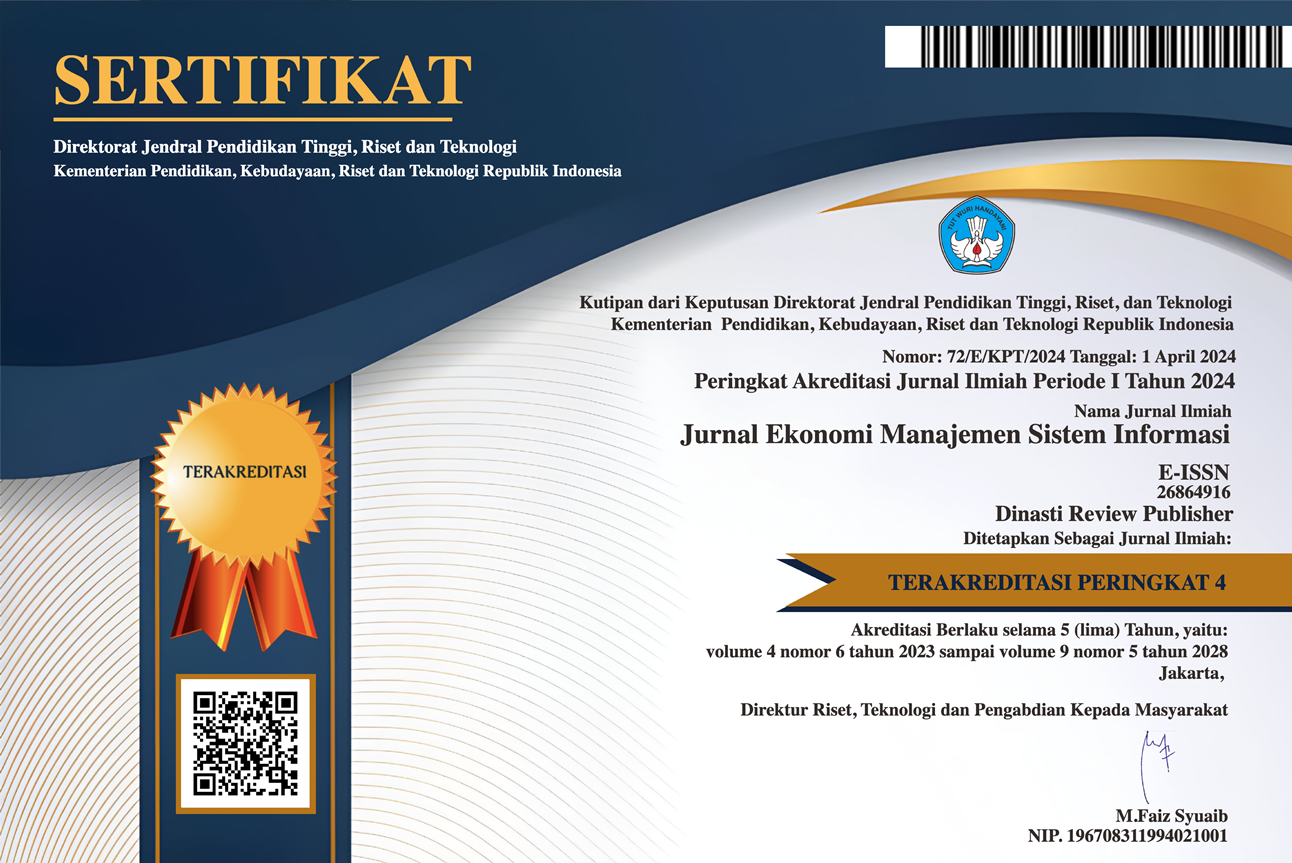Pengaruh CSR Terhadap Citra Merek, Ekuitas Merek dan Ewom serta Dampaknya Terhadap Kepuasan Pelanggan
DOI:
https://doi.org/10.38035/jemsi.v6i4.4523Keywords:
CSR, E-WOM, Citra Merek, Kepuasan Pelanggan, UsiaAbstract
Di era saat ini, pelanggan memiliki harapan tinggi terhadap merek, dan Corporate Social Responsibility (CSR) memainkan peran penting dalam menciptakan diferensiasi dari pesaing serta mempengaruhi keputusan pembelian dan kepuasan pelanggan. Penelitian ini bertujuan untuk menyelidiki pengaruh CSR terhadap citra merek, ekuitas merek, Electronic Word of Mouth (E-WOM), dan kepuasan pelanggan dalam konteks industri retail fashion. Metode penelitian yang digunakan adalah purposive sampling, melibatkan 255 pelanggan dari merek Guess, Charles & Keith, Pedro, Bonia, dan Coach di Jakarta yang telah membeli produk tas atau dompet minimal dua kali dalam enam bulan terakhir. Data dianalisis dengan Structural Equation Modeling (SEM) menggunakan SmartPLS 4.0. Temuan penelitian menunjukkan bahwa CSR memiliki pengaruh langsung dan signifikan terhadap citra merek, ekuitas merek, E-WOM, dan kepuasan pelanggan. Selain itu, citra merek dan E-WOM juga berpengaruh signifikan terhadap kepuasan pelanggan. Penelitian ini juga menemukan bahwa usia memoderasi hubungan antara CSR dan E-WOM, sedangkan ekuitas merek tidak berpengaruh signifikan terhadap kepuasan pelanggan. Implikasi manajerial dari penelitian ini menekankan manajer perlu memperbaiki E-WOM dengan menyediakan informasi produk yang jelas dan transparan. Terapkan CSR melalui program sosial yang terencana dan transparan, khususnya untuk generasi milenial dengan kelompok usia lebih tua, serta ciptakan citra merek yang simpatik untuk mendorong rekomendasi positif.
References
Aakash, A., & Aggarwal, A. G. (2020). Assessment of Hotel Performance and Guest Satisfaction through eWOM: Big Data for Better Insights. International Journal of Hospitality and Tourism Administration, 23(2), 317–346. https://doi.org/10.1080/15256480.2020.1746218
Aaker, D. (1996). Building Stronger Brands (hlm. 2–36).
Agyei, J., Sun, S., Penney, E. K., Abrokwah, E., & Ofori-Boafo, R. (2021). Linking CSR and Customer Engagement: The Role of Customer-Brand Identification and Customer Satisfaction. SAGE Open, 11(3). https://doi.org/10.1177/21582440211040113
Alakkas, A. A., Vivek, Paul, M., Nabi, M. K., & Khan, M. A. (2022). Corporate Social Responsibility and Firm-Based Brand Equity: The Moderating Effect of Marketing Communication and Brand Identity. Sustainability (Switzerland), 14(10), 1–21. https://doi.org/10.3390/su14106033
Al-Ghamdi, S. A. A., & Badawi, N. S. (2019). Do corporate social responsibility activities enhance customer satisfaction and customer loyalty? Evidence from the Saudi banking sector. Cogent Business and Management, 6(1), 1–20. https://doi.org/10.1080/23311975.2019.1662932
Ansary, A., & Hashim, N. M. H. N. (2018). Brand image and equity: The mediating role of brand equity drivers and moderating effects of product type and word of mouth. Review of Managerial Science, 12(4), 969–1002. https://doi.org/10.1007/s11846-017-0235-2
Arachchi, H. A. D. M., & Samarasinghe, G. D. (2023). Influence of corporate social responsibility and brand attitude on purchase intention. Spanish Journal of Marketing - ESIC, 27(3), 389–406. https://doi.org/10.1108/SJME-12-2021-0224
Araújo, J., Pereira, I. V., & Santos, J. D. (2023). The Effect of Corporate Social Responsibility on Brand Image and Brand Equity and Its Impact on Consumer Satisfaction. Administrative Sciences, 13(5). https://doi.org/10.3390/admsci13050118
Aslam, W., Farhat, K., & Arif, I. (2019). Role of electronic word of mouth on purchase intention. International Journal of Business Information Systems, 30(4), 411–426. https://doi.org/10.1504/IJBIS.2019.099304
Balderaz, B. G. B., & Campos, K. P. (2020). The Influence of Customer-Based Brand Equity on Online Shopping Satisfaction among Public Teachers in Davao Del Sur, Philippines. 9(2), 317–358.
Bhattacharya, A., Good, V., & Sardashti, H. (2020). Doing good when times are bad: The impact of CSR on brands during recessions. European Journal of Marketing, 54(9), 2049–2077. https://doi.org/10.1108/EJM-01-2019-0088
Bhattacharya, C. B., & Sen, S. (2004). Doing Better at Doing Good: When,Why, and How Consumers Respond to Corporate Social Initiatives. Clifornia Mnagement Review, 47(1), 9–24.
Biedenbach, G., Bengtsson, M., & Marell, A. (2015). Brand equity, satisfaction, and switching costs: An examination of effects in the business-to-business setting. Marketing Intelligence and Planning, 33(2), 164–178. https://doi.org/10.1108/mip-03-2014-0059
Bolton, R. N., Parasuraman, A., Hoefnagels, A., Migchels, N., Kabadayi, S., Gruber, T., Loureiro, Y. K., & Solnet, D. (2013). Understanding Generation Y and their use of social media: A review and research agenda. Journal of Service Management, 24(3), 245–267. https://doi.org/10.1108/09564231311326987
Büyükda?, N. (2021). The effect of brand awareness, brand image, satisfaction, brand loyalty and WOM on purchase intention: An empirical research on social media. Business & Management Studies: An International Journal, 9(4), 1380–1398. https://doi.org/10.15295/bmij.v9i4.1902
Casaló, L. V., Flavián, C., & Ibáñez-Sánchez, S. (2017). Antecedents of consumer intention to follow and recommend an Instagram account. Online Information Review, 41(7), 1046–1063. https://doi.org/10.1108/OIR-09-2016-0253
Chaudary, S., Zahid, Z., Shahid, S., Khan, S. N., & Azar, S. (2016). Customer perception of CSR initiatives: Its antecedents and consequences. Dalam Social Responsibility Journal (Vol. 12, Nomor 2). https://doi.org/10.1108/SRJ-04-2015-0056
Chen, F. Y., Chang, Y. H., & Lin, Y. H. (2012). Customer perceptions of airline social responsibility and its effect on loyalty. Journal of Air Transport Management, 20, 49–51. https://doi.org/10.1016/j.jairtraman.2011.11.007
Cheng, G., Cherian, J., Sial, M. S., Mentel, G., Wan, P., Álvarez-Otero, S., & Saleem, U. (2021). The relationship between csr communication on social media, purchase intention, and e-wom in the banking sector of an emerging economy. Journal of Theoretical and Applied Electronic Commerce Research, 16(4), 1025–1041. https://doi.org/10.3390/JTAER16040058
Chevalier, & Mayzlin. (2006). The Effect of Word of Mouth on Sales: Online Book Reviews. Journal of Marketing Research, XLIII(August), 345–354.
Chinelato, F. B., Oliveira, A. S. de, & Souki, G. Q. (2023). Do satisfied customers recommend restaurants? The moderating effect of engagement on social networks on the relationship between satisfaction and eWOM. Asia Pacific Journal of Marketing and Logistics, 35(11), 2765–2784. https://doi.org/10.1108/APJML-02-2022-0153
Chu, S. C., & Chen, H. T. (2019). Impact of consumers’ corporate social responsibility-related activities in social media on brand attitude, electronic word-of-mouth intention, and purchase intention: A study of Chinese consumer behavior. Journal of Consumer Behaviour, 18(6), 453–462. https://doi.org/10.1002/cb.1784
Cowan, K., & Guzman, F. (2020). How CSR reputation, sustainability signals, and country-of-origin sustainability reputation contribute to corporate brand performance: An exploratory study. Journal of Business Research, 117(November), 683–693. https://doi.org/10.1016/j.jbusres.2018.11.017
Cuong, D. T. (2020). The mediatory impact of brand loyalty and brand image on brand equity. African Journal of Business Management, 6(17), 69–077. https://doi.org/10.5897/ajbm11.788
Dwivedi, A. (2015). A higher-order model of consumer brand engagement and its impact on loyalty intentions. Journal of Retailing and Consumer Services, 24(C), 100–109. https://doi.org/10.1016/j.jretconser.2015.02.007
Echeverria-Rios, O. M., Albrego-Almazan, D., & Medina-Quintero, J. M. (2017). La responsabilidad social empresarial en la imagen de marca afectiva y reputación. Innovar, 28(69), 133–148. https://doi.org/0.15446/innovar.v28n69.71
Elizar, C., Indrawati, R., & Syah, T. Y. R. (2020). Service Quality, Customer Satisfaction, Customer Trust, and Customer Loyalty in Service of Paediatric Polyclinic Over Private H Hospital of East Jakarta, Indonesia. Journal of Multidisciplinary Academic, 4(2), 105–111.
Esmaeilpour, M., & Barjoei, S. (2016). The effect of corporate image on customer satisfaction through Brand equity. Advances in Management & Applied Economics, 6(4), 1792–7552.
Fatma, M., Khan, I., & Rahman, Z. (2018). CSR and consumer behavioral responses: The role of customer-company identification. Asia Pacific Journal of Marketing and Logistics, 30(2), 460–477. https://doi.org/10.1108/APJML-01-2017-0017
Foroudi, P., Jin, Z., Gupta, S., Foroudi, M. M., & Kitchen, P. J. (2018). Perceptional components of brand equity: Configuring the Symmetrical and Asymmetrical Paths to brand loyalty and brand purchase intention. Journal of Business Research, 89(January), 462–474. https://doi.org/10.1016/j.jbusres.2018.01.031
Galbreath, J., & Shum, P. (2012). Do customer satisfaction and reputation mediate the CSR-FP link? Evidence from Australia. Australian Journal of Management, 37(2), 211–229. https://doi.org/10.1177/0312896211432941
Hafez, M. (2018). Measuring the impact of corporate social responsibility practices on brand equity in the banking industry in Bangladesh: The mediating effect of corporate image and brand awareness. International Journal of Bank Marketing, 36(5), 806–822. https://doi.org/10.1108/IJBM-04-2017-0072
Hair, J. F., Hult, G. T. M., Ringle, C. M., Sarstedt, M., Danks, N. P., & Ray, S. (2021). An Introduction to Structural Equation Modeling. https://doi.org/10.1007/978-3-030-80519-7_1
Hair, J. F., Ringle, C. M., Hult, G. T., & Sarstedt, M. (2017). A Primer on Partial Least Squares Structural Equation Modeling. SAGE Publications, 46(1–2), 184–185. https://doi.org/10.1016/j.lrp.2013.01.002
Hair, J. F., Risher, J. J., Sarstedt, M., & Ringle, C. M. (2019). When to use and how to report the results of PLS-SEM. European Business Review, 31(1), 2–24. https://doi.org/10.1108/EBR-11-2018-0203
Harjoto, M. A., & Salas, J. (2017). Strategic and institutional sustainability: Corporate social responsibility, brand value, and Interbrand listing. Journal of Product and Brand Management, 26(6), 545–558. https://doi.org/10.1108/JPBM-07-2016-1277
Henseler, J., Ringle, C. M., & Sinkovics, R. R. (2009). The use of partial least squares path modeling in international marketing. Advances in International Marketing, 20(2009), 277–319. https://doi.org/10.1108/S1474-7979(2009)0000020014
Hossain, Md. S., Rayhan, Md. J., Uddin, M., & Rahman, S. M. M. (2023). Analyzing the Level of CSR Practices in Relation to Customer Satisfaction in the Context of Banking Industry in Bangladesh. International Journal of Economics and Financial Issues, 13(4), 92–101. https://doi.org/10.32479/ijefi.14523
Hosseini, S. H. K., & Behboudi, L. (2017). Brand trust and image: Effects on customer satisfaction. International Journal of Health Care Quality Assurance, 30(7), 580–590. https://doi.org/10.1108/IJHCQA-04-2016-0054
Irshad, A., Rahim, A., Khan, M. F., & Khan, M. M. (2017). The Impact of Corporate Social Responsibility on Customer Satisfaction and Customer Loyalty, Moderating Effect of Corporate Image (Evidence From Pakistan). City University Research Journal Special Issue: AIC, Malaysia PP, 63–73.
Jafari, S. M. B., Karimi, A., Forouzandeh, M., & Safahani, N. (2015). The effect of brand commitment on e-WOM and brand image in the mobile market. Research Journal of Applied Sciences, 10(10), 519–524. https://doi.org/10.3923/rjasci.2015.519.524
Jannoo, Z., Yap, B. W., Auchoybur, N., & Lazim, M. A. (2014). 2014 Effect of Nonnormality on CBSEM PLSEM. 8(2), 285–291.
Jin, B., & Hongjoo. (2013). As only product responsibility, economics, and environment-related CSR dimensions significantly enhance brand equity,.
Karyose, H., Astuti, W., & Ferdiansjah, A. (2017). Customer Loyalty: The Effect of Service Quality, Corporate Image, Customer Relationship Marketing and Customer Satisfaction as Intervening Variable-An Empirical Analysis of Bank Customers in Malang City. Marketing and Branding Research, 4(4), 336–347. https://doi.org/10.33844/mbr.2017.60334
Kock, N. (2016). Non-normality propagation among latent variables and indicators in PLS-SEM simulations. Journal of Modern Applied Statistical Methods, 15(1), 299–315. https://doi.org/10.22237/jmasm/1462076100
Kumar, A. (2014). Brand Equity and Customer Satisfaction – a Study of Lg Television in Mysore District. International Journal of Management Research & Review, 4(5), 610–615.
Kuo, H. C., & Nakhata, C. (2019). The Impact of Electronic Word-of-Mouth on Customer Satisfaction. Journal of Marketing Theory and Practice, 27(3), 331–348. https://doi.org/10.1080/10696679.2019.1615840
Kuokkanen, H., & Sun, W. (2020). Companies, Meet Ethical Consumers: Strategic CSR Management to Impact Consumer Choice. Journal of Business Ethics, 166(2), 403–423. https://doi.org/10.1007/s10551-019-04145-4
Lam, S. Y., Shankar, V., Erramilli, M. K., & Murthy, B. (2004). Customer value, satisfaction, loyalty, and switching costs: An illustration from a business-to-business service context. Journal of the Academy of Marketing Science, 32(3), 293–311. https://doi.org/10.1177/0092070304263330
Lee, S., Han, H., Radic, A., & Tariq, B. (2020). Corporate social responsibility (CSR) as a customer satisfaction and retention strategy in the chain restaurant sector. Journal of Hospitality and Tourism Management, 45(August), 348–358. https://doi.org/10.1016/j.jhtm.2020.09.002
Le-Hoang, P. V. (2020). The relationship between online convenience, online customer satisfaction, buying intention and electronic word-of-mouth. Independent Journal of Management & Production, 11(7), 2943–2966. https://doi.org/10.14807/ijmp.v11i7.1251
Lin, M. S., & Chung, Y. K. (2019). Understanding the impacts of corporate social responsibility and brand attributes on brand equity in the restaurant industry. Tourism Economics, 25(4), 639–658. https://doi.org/10.1177/1354816618813619
Lu, J., Ren, L., Zhang, C., Wang, C., Shahid, Z., & Streimikis, J. (2020). The influence of a firm?s CSR initiatives on brand loyalty and brand image. Journal of Competitiveness, 12(2), 106–124. https://doi.org/10.7441/joc.2020.02.07
Lucky, O. S., Aisjah, S., & Ningrum, A. P. (2023). The impacts of store price image and brand image on repurchase intention with customer satisfaction as mediation. International Journal of Research in Business and Social Science (2147- 4478), 12(1), 22–30. https://doi.org/10.20525/ijrbs.v12i1.2269
Ma, S. C., & Kaplanidou, K. (2021). How Corporate Social Responsibility and Social Identities Lead to Corporate Brand Equity: An Evaluation in the Context of Sport Teams as Brand Extensions. Sport Marketing Quarterly, 30(1), 16–29. https://doi.org/10.32731/SMQ.301.032021.02
Markovic, S., Iglesias, O., Singh, J. J., & Sierra, V. (2018). How does the Perceived Ethicality of Corporate Services Brands Influence Loyalty and Positive Word-of-Mouth? Analyzing the Roles of Empathy, Affective Commitment, and Perceived Quality. Journal of Business Ethics, 148(4), 721–740. https://doi.org/10.1007/s10551-015-2985-6
Martínez, P., Pérez, A., & Bosque, I. R. Del. (2014). CSR influence on hotel brand image and loyalty. Academia Revista Latinoamericana de Administracion, 27(2), 267–283. https://doi.org/10.1108/ARLA-12-2013-0190
McDonald, L. M., & Rundle-Thiele, S. (2008). Corporate social responsibility and bank customer satisfaction: A research agenda. International Journal of Bank Marketing, 26(3), 170–182. https://doi.org/10.1108/02652320810864643
Mehta, A. M. (2020). How Brand Image and Perceived Service Quality Affect Customer Loyalty Through Customer Satisfaction. Academy of Marketing Studies Journal, 24(March), 1–11.
Mirabi, V. R., Asgari, A., & Tehrani, A. G. (2014). A Survey on the Relationship between Brand Equity of Etka Store and Customer Satisfaction. Kuwait Chapter of Arabian Journal of Business and Management Review, 3(7), 405–416. https://doi.org/10.12816/0018299
Mohammed, A., & Rashid, B. (2018). A conceptual model of corporate social responsibility dimensions, brand image, and customer satisfaction in Malaysian hotel industry. Kasetsart Journal of Social Sciences, 39(2), 358–364. https://doi.org/10.1016/j.kjss.2018.04.001
Moise, M. S., Gil-Saura, I., Šeri?, M., & Molina, M. E. R. (2019). Influence of environmental practices on brand equity, satisfaction and word of mouth. Journal of Brand Management, 26(6), 646–657. https://doi.org/10.1057/s41262-019-00160-y
Moorthy, K., T’ing, L. C., Na, S. A., Ching, C. T., Loong, L. Y., Xian, L. S., & Ling, T. W. (2017). Corporate image no longer leads to customer satisfaction and loyalty. Emerald Insight.
Nyadzayo, M. W., Johnson, L. W., & Rossi, M. (2020). Drivers and outcomes of brand engagement in self-concept for luxury fashion brands. Journal of Fashion Marketing and Management, 24(4), 589–609. https://doi.org/10.1108/JFMM-05-2018-0070
Oppong, P. K., Mensah, J., & Addae, M. (2022). Effect of Brand Equity on Consumers` Word-of-Mouth Behaviour in Herbal Market in Ghana. African Journal of Business and Economic Research, 17(3), 191–212. https://doi.org/10.31920/1750-4562/2022/V17N3A9
Özkan, P., Süer, S., Keser, ?. K., & Kocakoç, ?. D. (2020). The effect of service quality and customer satisfaction on customer loyalty: The mediation of perceived value of services, corporate image, and corporate reputation. International Journal of Bank Marketing, 38(2), 384–405. https://doi.org/10.1108/IJBM-03-2019-0096
Poudyal, A., & Yukongdi, V. (2020). The Influence of Corporate Social Responsibility on Brand Image: A Study of Nepalese Commercial Bank Customers. Review of Integrative Business and Economics Research, 9(4), 176–192.
Putra, T. R. I., Ridwan, & Kalvin, M. (2020). How Electronic Word of Mount (E-Wom) Affects Purchase Intention with Brand Image As A Mediation Variable: Case of Xiaomi Smartphone in Student. Journal of Physics: Conference Series, 1500(1). https://doi.org/10.1088/1742-6596/1500/1/012094
Rambocas, M., Kirpalani, V. M., & Simms, E. (2018). Brand equity and customer behavioral intentions: A mediated moderated model. International Journal of Bank Marketing, 36(1), 19–40. https://doi.org/10.1108/IJBM-09-2016-0139
Rodríguez, P. G., Valiño, P. C., & Burguete, J. L. V. (2017). The effects of corporate social responsibility on customer-based brand equity: Spanish hypermarket case. Economic Research-Ekonomska Istrazivanja , 30(1), 290–301. https://doi.org/10.1080/1331677X.2017.1305797
Sabrina, H. L., Helmi, R. A., Komaladewi, R., & Yacob, S. (2022). Model of the intention of registration on video-on-demand streaming services. International Journal of Research in Business and Social Science (2147- 4478), 11(2), 74–82. https://doi.org/10.20525/ijrbs.v11i2.1636
?e?en, H., & Gündo?du, A. (2023). Corporate Social Responsibility, Corporate Reputation and Corporate Image: Testing a Mediational Model. International Journal of Business, 28(1), 2–17. https://doi.org/10.55802/IJB.028(1).003
Shahzad, K., Ahmad, I., & Gul, A. (2019). Mediating Role of Customer Satisfaction between Corporate Social Responsibility and Customer-Based Brand Equity. Business & Economic Review, 11(1), 123–144. https://doi.org/10.22547/ber/11.1.6
Singh, A., & Verma, P. (2019). The impact of corporate social responsibility on brand equity of Indian firms. International Journal of Business Innovation and Research, 20(1), 64–86. https://doi.org/10.1504/IJBIR.2019.101689
Sofyan, M. (2017). The influence of corporate CSR on brand image and brand loyalty. Jurnal Siasat Bisnis, 21(1), 1–18. https://doi.org/10.20885/jsb.vol21.iss1.art1
Syah, T. Y. R., & Olivia, D. (2022). Enhancing Patronage Intention on Online Fashion Industry in Indonesia: The Role of Value Co-Creation, Brand Image, and E-Service Quality. Cogent Business and Management, 9(1). https://doi.org/10.1080/23311975.2022.2065790
Tandon, A., Aakash, A., & Aggarwal, A. G. (2020). Impact of EWOM, website quality, and product satisfaction on customer satisfaction and repurchase intention: Moderating role of shipping and handling. International Journal of System Assurance Engineering and Management, 11, 349–356. https://doi.org/10.1007/s13198-020-00954-3
Tanveer, Z., & Lodhi, R. N. (2016). The Effect of Brand Equity on Customer Satisfaction: An Empirical Study Based on David Aaker’s Brand Equity Model. IUP Journal of Brand Management, 13(3), 43-.
Tsai, C.-M. (2021). Do Perceived Quality and Brand Image Still Affect Customer Satisfaction in Hospitals During the COVID-19 Pandemic? Journal of Business Administration, 46(3), 1–17. https://doi.org/10.3966/102596272021090463001
Vuong, T. K., & Bui, H. M. (2023). The role of corporate social responsibility activities in employees’ perception of brand reputation and brand equity. Case Studies in Chemical and Environmental Engineering, 7. https://doi.org/10.1016/j.cscee.2023.100313
Wang, C. C. (2020). Corporate social responsibility on customer behaviour: The mediating role of corporate image and customer satisfaction. Total Quality Management and Business Excellence, 31(7–8), 742–760. https://doi.org/10.1080/14783363.2018.1444985
Wei, G., Lin, W., Yanxiong, W., Jingdong, Y., & Musse, S. Y. (2021). The relationship of sustainability communication on social media with banking consumers’ loyalty through e-WOM. Sustainability (Switzerland), 13(7), 1–14. https://doi.org/10.3390/su13073832
Yang, J., & Basile, K. (2019). The impact of corporate social responsibility on brand equity. Marketing Intelligence and Planning, 37(1), 2–17. https://doi.org/10.1108/MIP-02-2018-0051
Yilmazel, S. E., & Karademir, A. C. (2022). Impact of corporate social responsibility performed by Turkish banks related to COVID-19 on customer satisfaction and loyalty. Business & Management Studies: An International Journal, 10(4), 1228–1240. https://doi.org/10.15295/bmij.v10i4.2121
Yoo, B., & Donthu, N. (2001). Developing and validating a multidimensional consumer-based brand equity scale. Journal of Business Research, 52(1), 1–14. https://doi.org/10.1016/S0148-2963(99)00098-3
Zameer, H., Tara, A., Kausar, U., & Mohsin, A. (2015). Impact of service quality, corporate image and customer satisfaction towards customers’ perceived value in the banking sector in Pakistan. International Journal of Bank Marketing, 33(4), 442–456. https://doi.org/10.1108/IJBM-01-2014-0015
Zhang, Y. (2015). The Impact of Brand Image on Consumer Behavior: A Literature Review. Open Journal of Business and Management, 03(01), 58–62. https://doi.org/10.4236/ojbm.2015.31006
Zhao, Y., Abbas, M., Samma, M., Ozkut, T., Munir, M., & Rasool, S. F. (2021). Exploring the Relationship Between Corporate Social Responsibility, Trust, Corporate Reputation, and Brand Equity. Frontiers in Psychology, 12(November), 1–10. https://doi.org/10.3389/fpsyg.2021.766422
Zhou, Z., & Zhang, Z. (Justin). (2019). Customer satisfaction of bicycle sharing: Studying perceived service quality with SEM model. International Journal of Logistics Research and Applications, 22(5), 437–448. https://doi.org/10.1080/13675567.2018.1513468
Downloads
Published
How to Cite
Issue
Section
License
Copyright (c) 2025 Ridwan Ibnu Khawari, Primasatria Edastama

This work is licensed under a Creative Commons Attribution 4.0 International License.
Hak cipta :
Penulis yang mempublikasikan manuskripnya di jurnal ini menyetujui ketentuan berikut:
- Hak cipta pada setiap artikel adalah milik penulis.
- Penulis mengakui bahwa Jurnal Ekonomi Manajemen Sistem Informasi (JEMSI) berhak menjadi yang pertama menerbitkan dengan lisensi Creative Commons Attribution 4.0 International (Attribution 4.0 International CC BY 4.0) .
- Penulis dapat mengirimkan artikel secara terpisah, mengatur distribusi non-eksklusif manuskrip yang telah diterbitkan dalam jurnal ini ke versi lain (misalnya, dikirim ke repositori institusi penulis, publikasi ke dalam buku, dll.), dengan mengakui bahwa manuskrip telah diterbitkan pertama kali di Jurnal Ekonomi Manajemen Sistem Informasi (JEMSI).











































































